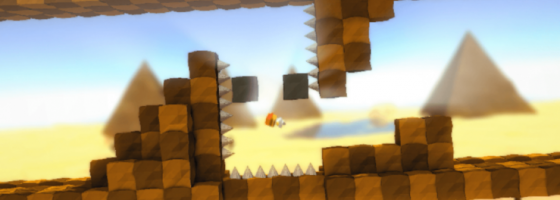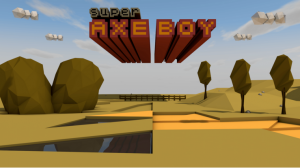This week, the kickstarter for the 2d/3d platformer Super Axe Boy went live. The game is about recapturing old school platformer gameplay with the added twist of 2d and 3d level design. I had a chance to talk to lead developer Matthias Falk and ask him some questions about the game and platformer design.
1. To get things started, could you tell us a little bit about yourself and how you got started making games?
I’ve always loved games (got an NES when I was 5 and did every console generation since then) and I’ve always experimented with smaller projects that I kept for myself. It might sound cheesy, but when I watched “Indie Games: The Movie” it was the moment when I decided to take things to the next level and build some small iPhone games where I could deepen my experience in programming and designing games.
2. The platformer as a genre, has been the go-to genre for Indie devs for awhile now and is considered flooded by a lot of consumers. What made you decide to go it for Super Axe Boy?
I think you should try and do something you really love yourself. Platformers were always my favorite genre and it’s always nice to try a new one, since platformers can be a place to have a good time and to experience some crazy and creative gameplay moments.
3. And continuing from that question, what makes Super Axe Boy stand out from the other platformers on the market?
I think it’s very unique that the game is switching back and forth between 2D and 3D situations and puts this to the core of the level design. Many players can hopefully relate to this, since they grew up with 8-bit and 16-bit titles such as Mario and then moved on to 3D titles. This game tries to bring together those two experiences as one.
Also, since the main character is an axe-wielding lumberjack this gives a lot of possibilities to do fresh gameplay mechanics (like hacking trees or changing the level structure with your axe, manipulating your environment to defeat bosses and so on).
Also, I think a lot of the game’s personality is conveyed by its unique graphical style.
4. For people who haven’t visited the kickstarter yet, how much of Super Axe Boy is “done” in terms of development?
The game’s pre-production stage is done, this means that the game design is written, the main character and core gameplay elements are done, the story is outlined and the game engine that powers the 2D and 3D situations is up and ready (the video trailer is a good example of what the engine is capable of).
As a next step, graphical (enemies, game objects, levels) and audio assets need to be created, in order to finish the game. This process takes time and money. Thus, the game is now on Kickstarter in order to involve the community and make Super Axe Boy happen!
5. The art style has a good unified aesthetic to it. How did you decide on the look of the game?
I wanted to do something that is very simplistic and retro but on the other hand is very modern and vivid at the same time. I think that many gamers that grew up with the old consoles and haven’t stopped playing games can relate to that.
6. One of the interesting discoveries from playing and learning Super Mario Maker, is getting a deeper insight into good game design; specifically with platformer design. As someone who has obviously looked at classic platformer gameplay for Super Axe Boy, what are your thoughts on what goes into great level design?
I think it is very easy to make a super-difficult level or something that trolls people (it’s crazy what’s going on on Mario Maker). What makes a “good” level is very difficult to answer – I think it is about reaching a kind of balance where a level is “fun” but gives a good “challenge” at the same time, always giving the player the feeling that something is doable without being unfair to him. Clearly, a lot of testing, reiterating ideas and getting feedback from playtesters has to go into that.

The use of 3D and 2D design will hopefully give the game a unique charm compared to other Indie platformers
7. Continuing from that question, another challenge with level design is figuring out when something doesn’t work. In you opinion, what are some elements that someone should avoid when making a platformer and how has that affected Super Axe Boy?
I think it’s very important to have focus and discipline when designing a level and to not throw too many different things and ideas at the player at the same time (even though you could as a designer). If you take a good look at many great platformers of recent times (like Mario, Fez, Guacemelee etc.)
You can see that these games are extremely focussed on giving players a gentle learning curve of how controls work or what you need to do to pass an obstacle. A game like Mario is never giving you more than 1 or 2 “ideas” at the same time in a level, so that a player is never overwhelmed and always “gets” what he has to do.
8. Lastly for the fans or newcomers reading this interview, do you have any final thoughts you would like to end on?
I am very excited about Super Axe Boy and I hope that many players will be too. This project is as Indie as it gets and I know that only with a good community the game will succeed on Kickstarter. So, every kind of help is very much appreciated.
For more on Super Axe Boy , you can follow the game on Twitter.



